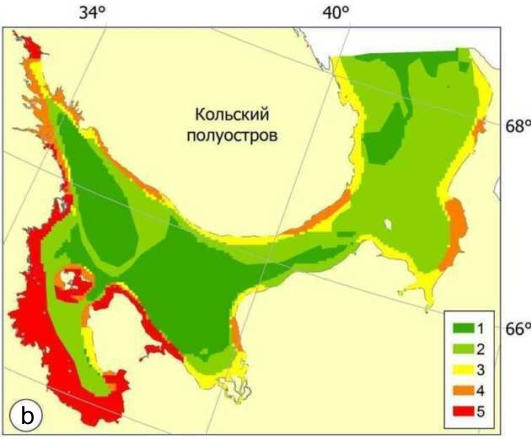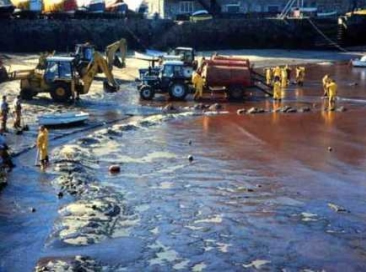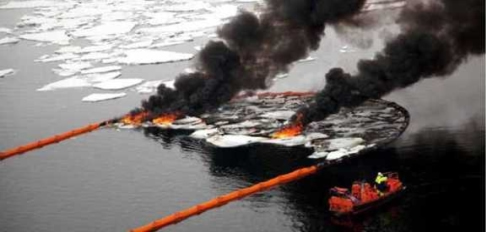2.15. Pilot Project: "Improving the Oil Spill Response System in the Arctic Con-text for the Protection of Coastal Areas that are Specifically Responsive to Oil Products (as Demonstrated in the Context of the Barents and White Seas)"
The Project Goal was to develop proposals for improving the system of responding to oil spills in the Arctic context by the Russian emergency management services, port authorities and other specialized services and units for the protection of coastal areas that are specifically responsive to oil products.
The Project was implemented by OOO Rambol Barents.
The Project Duration 20 August – 30 November 2010
The Project Activities
To meet its goals and objectives, the Consultant:
- Analyzed Russian and foreign experience (including experience in the Nordic countries) of responding to oil and oil products spills in an environment similar to the Barents/Euro-Arctic region;
- Analyzed the current system for responding to oil and oil product spills in the Russian Arctic, and outlined the improvement priorities;
- Prepared maps of coastal areas that are specifically responsive to oil spills in the Barents and White Seas;
- Carried out computer modeling of the properties of the main oils and oil products transported through the Barents and White seas and studied their behavior on the water surface under different meteorological conditions;
- Analyzed cumulative environmental benefit from the application of various methods of (i) responding to an oil and oil products spill and (ii) protecting the coastal areas in the Barents and White Seas with specific response to such spills;
- Worked out a decision-making algorithm for the Russian emergency management services, port authorities and other specialized services and units concerning application of oil and oil spills response technologies;
- Prepared draft guidelines “Improving the Oil Spill Response System in the Arctic Context for the Protection of Coastal Areas that are Specifically Responsive to Oil Products (as Demonstrated in the Context of the Barents and White Seas)”
- Submitted proposals for an investment project concerning oil and oil product spill response in the Arctic context;
- Held the project completion meeting to provide for the dissemination of the project related experience among the stakeholders;
The Project Outcomes
The Project reviewed the Russian system of responding to oil spills at sea as an organizational structure based on three pillars, which were extensively studied and analyzed, namely:
- Legislative framework comprised of regulations governing the operation of the response system and interaction of its elements;
- Scientific and methodological documents including a set of sound methodologies and recommendations for the prediction and prevention of pollution, and the carrying out of oil spill response operations (OSR).
- Resource framework including a set of resources to tackle practical operational tasks with respect to the prevention of and response to oil spills (offshore and onshore infrastructure, specialized machinery and equipment, communications equipment, skilled staff, managers, equipment operators, manpower, financial provisions, insurance system, information resources, data collection and transmission system, etc.).
The analysis showed that after major oil spills with serious and, sometimes, catastrophic consequences, the world public and national governments understand the need in revisiting and improving the national oil spills response systems. Steps would be taken to strengthen international environmental standards and requirements. However, the existing environmental requirements and safety regulations at sea, both at global and national levels, can not to date guarantee that there will be no emergencies resulting in oil spills in the Arctic marine waters.
In the international and Russian practice, there are common approaches and methods for responding to oil spills in marine waters, but the choice of an OSR technology may depend on national rules and standards as adopted by a specific country. Nevertheless, all the Arctic countries find it too complicated or even impossible to use standard OSR technologies in the Arctic. It is necessary to find new response techniques that would be effective in the harsh natural conditions, particularly in the ice conditions.
For the Russian Federation, improving the regulatory and legal framework must be one of the top priorities in preventing and responding to oil spills. Regulation should focus on achieving long-term effects and synchronizing management decisions with other nations, first of all with all the Arctic countries.
In accordance with the national requirements of the Russian Federation, oil spill response operations should be planned and priority protection areas should be selected on the basis of risk assessments with due regard to local conditions, nature of the territory and water area, and its environmental characteristics. For background information in this case, one usually takes the data on the distribution of various species of animals and plants, presence of specially protected areas (PAs) and other valuable natural sites in the area to be affected by an oil spill. To this end, the Project prepared maps of "relative" and "absolute" vulnerability of the Barents and White seas from oil spills, taking into account seasonal differences. By using the "relative" vulnerability maps, one can compare individual sea areas during one season. However, where it is necessary to compare vulnerability between the seasons, one should use the "absolute" vulnerability maps.


Figure 46. Examples of Maps of Integrated Vulnerability of the Barents (a) and White (b) Seas by Seasons
The White Sea maps of the integrated vulnerability show that in different seasons the coastal areas are the most vulnerable areas (as is the case with the Barents Sea). This is mainly the west coast of the White Sea from Kandalaksha to Onega Bay.
Based on the experience gained, the Project offered recommendations for mapping coastal areas with specific response to oil spills. The maps should provide clear and visual information to spill response teams. They should have an integrated characteristic of the coast structure and its morphological features expressed as an index of specific response to oil spills. They also should feature information concerning biological diversity, productivity and natural resources use sites in the coastal and marine areas. Different coast types must be indicated by symbols. Maps of coastal areas with specific response to oil spills should be prepared in three scales, with the corresponding information on them for each scale.
Small-scale maps should be a base map of the entire sea area including an outline of the shoreline, depth contours, contour line, the position of ice edge to reflect hydrological conditions and fishing areas, migration routes of marine biota. The charts of such a scale must show the main oil and oil products transportation routes, existing and planned terminals and pipelines.
Medium-and large-scale maps should show:
- Representative shores types with the environmental sensitivity index (ESI);
- The biological productivity of coastal waters and shoreline, as well as habitats and migration routes of birds and marine mammals, protected areas, important bird areas, and maritime marshes. The coast and shoreline should be ranked according to their vulnerability in terms of concentration of biota on the shore;
- Natural resources, recreational resources, sites of cultural, historic and scientific importance, access roads, coastal infrastructure, as well as the boundary of water protection zone for the Barents and White seas;
- The habitat beyond the tidal zone and coastal zone of fishing in shallow water, the areas for the collection of algae, shellfish banks in the intertidal zone or in shallow water near the coast, areas of fish and shellfish farming, rivers flowing into the sea, etc.
- Areas where dispersing agents can be used, and where they should not be used, where possible to deploy booms and their places of permanent mooring booms. It should show a "sacrificial zone", characterized by low vulnerability, which could if necessary, to send an oil slick for the salvation of areas of high ecological sensitivity (vulnerability), and places with paragraphs entrance.
In spills on water, oil behavior depends on oil properties. There are two distinct groups of most probable oil behaviors after a spill reaches the shore:
- Oil that is largely subject to the weathering process (e.g., evaporation and dispersion) and rapid natural decomposition of oil is expected. This group includes naphtha and gas condensate stable (CSC).
- Oil that is little subject to weathering process reaching the coastal zone virtually unchanged after the spill. This group includes crude oil and M-100 fuel oil.

Figure 47. Cleanup of Oily Beach
The procedure for analyzing and selecting the most effective oil spill response approaches, whose application will minimize the negative impact on the environment, is called the Net Environmental Benefit Analysis (NEBA). The purpose of NEBA is to determine a response methodology to either reduce the time required for natural recovery, or to restore natural environment in the oil affected area to the levels that are as close to the natural levels as possible. NEBA involves an informed decision making process as to whether an oil spill response is really needed, given potential environmental consequences. The starting point is the reference conditions to be compared with the likely outcome of intervention. It is also necessary to analyze a) the need in the clean-up, and b) the choice of the technology to be applied. The level of damage should be analyzed as compared to the possibility of remediating the affected area. In some cases it is measured as a time period. Moreover, some intervention may cause additional damage, but overall, such intervention should minimizing damage.

Figure 48. Testing Incineration Technology
Despite the fact that this is a rather obvious approach, there are many examples where the clean-up activities, undertaken with the intention of reducing the environmental damage, inflicted more damage than oil itself. In the Barents and White seas it is extremely difficult to combat large oil spills at sea. Although containment and mechanical recovery of oil is the preferred option of oil spill response at sea, there are many reasons why this may be an ineffective approach. In case of light oil spills the best response option will be to monitor oil spills until they decompose in an natural way, especially if the oil is far from the coast and rapidly decomposes.
This analysis served as a basis for developing a decision-making algorithm for OSR technique application. Mechanical techniques of OSR are the preferred approach to respond to an oil spill in the Arctic waters in terms of minimizing the impact on sensitive areas. The algorithm also includes alternative response techniques such as incineration and the use of dispersing agents. Taking into account the specific nature of oil spill responses in the Barents and White seas and the fact that particularly sensitive areas are located very close to the main waterways, this algorithm could undergo substantial optimization. Understanding that major oil spills in the Barents Sea could be of transboundary nature, it might be practical to develop common international guidelines and criteria for selecting OSR technologies for the Barents/Euro-Arctic Region.
The findings of the Pilot Project and stakeholder comments helped formulate proposals and recommendations that may be useful in developing measures to improve Russia's national OSR system and ensure the necessary level of preparedness to respond to potential oil spills in the Arctic. Suggestions and recommendations are divided into blocks according to the organizational structure of the oil spill response system, as adopted in the pilot project:
- Proposals and recommendations to improve the regulatory framework for the Arctic oil spill response system;
- Proposals and recommendations to improve the scientific and methodological framework for the Arctic oil spill response system;
- Proposals and recommendations to improve the resource framework for the Arctic oil spill response system;
The Project proposed the investment project "A Feasibility Study for the Establishment of an Intermediate Base Station for OSR Facilities on the Kola Peninsula Coast in Order to Ensure Timely Response to Potential Oil Spills". It includes a number of interrelated activities aimed at conducting a comprehensive study concerning the establishment of high-performance unit titled FGUP “Murmansk Basin Emergency and Rescue Management Administration" on a remote stretch of the Kola Peninsula coast. The goal of the project is to carry out a set of in-depth studies to fully and objectively evaluate the need in and feasibility of creating intermediate OSR base stations on remote stretches of the coast. For greater objectivity of the studies, they will be implemented as a demonstration project in a specific land area on the Kola Peninsula coast.
Experience gained under this pilot project, and draft recommendations were circulated among the organizations concerned. Additional recommendations received as comments and suggestions from OSR experts were reviewed and incorporated in the final draft Guidelines.
Details of the recommendations and the proposed investment project are in the report which is posted on the NPA-Arctic project site http://www.npa-arctic.ru.
♦ ♦ ♦
| « Previous | Table of Contents |